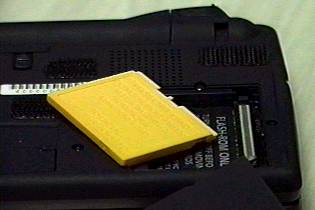











RAM/ROM
And everything Miniature Card
This area is for Q&A relating to Velo hardware issues. Rather than trying to maintain a complicated list of inter-document bookmarks, please use the site search engine, or CONTROL+F to attempt to FIND a specific term on this page.
There are three main pages for HARDWARE ISSUES: GENERAL HARDWARE - RAM/ROM - COMMUNICATIONS
What's the proper way to install a DRAM card?
This is something you can't skip over:
1. Back-up your data
2. Remove ALL batteries - both main and backup
3. Wait 5-10 minutes (THIS IS IMPORTANT!)
4. Install the DRAM card
5. Boot up the Velo, jump through the setup wizard, then do a soft reset
6. Change your connection speed to match the PC (i.e. - what it was before the hard reset)
7. Connect to your PC and do a full restore
8. Soft reset
9. You're done!
Can I upgrade my VELO 1? What are "miniature cards"? How do they relate to my VELO?
The VELO 1 is a highly upgradeable HPC. In fact, of all the 1st generation units, it is the most flexible. On the back of the unit, there are two small panels. Each panel fits a single miniature card (as shown below):

Miniature Cards are not PCMCIA cards, they are not CompactFlash cards (which the HP 320LX uses). Miniature Cards are a new standard developed my Intel, Microsoft, and others. Here's the official description from http://www.mcif.org (the Miniature Card Implementers Forum):
"The Miniature Card, is designed as a removable, reusable digital storage medium for handheld consumer electronic devices such as digital cameras, voice recorders, smart cellular phones and personal digital assistants (PDAs). These types of applications require small, rugged data storage media as well as a convenient method for bringing the data to a PC for manipulation. The Miniature Card Specification includes: a flexible host design that can accommodate up to 64-Megabytes of flash, ROM, and DRAM memory; a rugged pinless connector well-suited for consumer use; a 60-connection bus for ease of system integration and low-cost implementation, and a form factor measuring 38mm (width) x 33mm (length) x 3.5mm (height) for minimized card footprint. A 16-bit data path for high-performance transfers with high-capacity data storage also enables application or operating system code to be directly executed from the Miniature Card."
What's a "DRAM" miniature card? What's a "Flash" Miniature card? What's the difference?
DRAM is totally different from Flash. DRAM installs invisibly in your machine and acts just like the 4-8MB of existing EDO DRAM – you can proportion it between storage and execution, and you can basically forget it’s there once you plug it in. FLASH functions more like a removeable hard drive that can store things, but not actually run them. The DRAM cards are better suited to storing large files or databases.
The bottom line? If you want to make your VELO more useable, get the 4/8 meg DRAM upgrade. Since the CE 2.0 ROM chip needs to go into the Flash card slot on the back of the Velo 1, DRAM is a better solution.
So what’s a Flash card good for then?
Flash cards are still useful for storing a ton of programs and then "downloading" the ones you want to your DRAM to run. This is similar to storing extra stuff on your computer, but more convenient because you don’t have to be at the computer to get at it. Consider it a multi-tier approach to offline storage of sorts. Flash cards are also good for storing large amounts of data, like the Pocket Streets maps from Microsoft’s Automap Streets Plus application.
I've heard that DRAM miniature cards drain your battery? Is this true?
While it is true that the DRAM miniature cards require power to maintain their memory (like a computer does to retain information in RAM), the power drain is negligible. I'm using the 8 meg DRAM card, and I haven't noticed any day to day difference in Velo battery life.
Why can’t I run programs from my Flash card?
(all text in black is original FAQ text, all text in RED is from Greg Komoto Intel Corp, Memory Components Division - here's the real scoop kids! Also, below this is a "scathing" email from someone who corrected me on a great deal of Flash card inaccuracies. With all this information below, you can't go wrong!)
The Flash expansion cards you install are not normal RAM – they’re Flash storage. In the VELO world, Flash is treated as an extension of your virtual hard disk (what Windows CE calls the object store) but Flash is limited to only storing programs. I believe this is because Flash is slower to write to (technically speaking, the design of Flash is more complex, and those slower than DRAM to access), so executing programs would be met with mixed results.
Yes, it is slower to write to flash.
However, reading from flash and DRAM are more comparable. DRAM Miniature Cards are read
from at 70 ns per access. The flash cards used in the Velo are specified at 100 to
150 ns. (Actually system access speed may differ; note that this is different than ATA
flash or CompactFlash, which reads more like a disk drive because it is emulating a disk.
The Miniature Cards are linear memory -- very similar to ROMs.). This is the execution
speed that matters for program storage or even for direct execution.
Whatever the reason, it doesn’t work. You must first copy the program off the Flash card and into a storage area before running it. This process is automatic and seamless, however, if slow.
Actually, this nearly the same way programs that are loaded into "RAM", and not ROM, are executed. The process is automatic and seamless. Programs loaded into RAM or flash are both automatically copied into system RAM for execution. The difference is that the objects in RAM are stored compressed, and in flash they are not. So, although the flash is slightly slower to read, the program read does not have to be compressed.
The simplified version: think of Flash storage like you're normal hard drive. You have 4 megs to store stuff on, and when you want to run it, it loads the program into your 4 megs of RAM. You can only run as many programs as you have RAM. The loading/unloading process is seamless and automatic, but slower than having 100% system RAM.
(Paul: Very technical note about Flash: If I remember my VLSI class correctly, Flash RAM is organized into pages. To write to an address, you have to first read out the page, erase it, then write the new page. Since pages are pretty large, this makes it an inefficient technology for running programs from. It’s good for storing data and still being re-writeable. I might be wrong, but I think this is the real reason we cannot execute programs from Flash. If you have a different theory, I’d love to hear it.)
Actually, this is incorrect. There are many types of flash memory. The type used in the Miniature Cards is linear flash, which allows for direct execution. You can run any software from flash memory -- in fact, that is the most prevalent usage (i.e., the memory in a cell phone). For example, early production runs of many HPCs use flash memory instead of ROM for the main code storage. One LG model actually uses flash instead of ROM -- it allows you to update the flash when the new OS is available. Linear flash is random memory. You can read or write a byte at a time. However, data must be erased in large blocks. However, for program execution, the actual executable program is never written to. Thus, flash or ROM or RAM can all be used to run code.
Subject:
Inaccuracies in VELO FAQ
First of all, speed: the DRAM in the Velo is about 70ns RAM. Flash memory works at
about 100ns, not milliseconds.
Flash card "wear": the wear only occurs as writes
are performed; reading does not affect the card. After about 250,000 writes, writing will
take several times longer. However, this is still far more long-lasting than a
hard drive, and NO ONE HAS EVER HIT THIS LIMIT with normal use.
It's not Flash RAM, either!
Flash memory is a bank of EEPROM (electrically erasable programmable read only memory)
that has an IDE controller chip for low-level access (assuming ATA memory). It's ROM, not
RAM. It's totally different. Only
superficially, from a layman's point of view would you call it "RAM" because,
yes, in a way, you can write to it.
If you have no idea what you're talking about, don't tell it to others.
Nick Dolezal
[email protected]
Can I use miniature cards made by companies other than Philips?
Yes. Now that Philips has the Flash Miniature card software for CE 2.0 and the Velo 500 available for download (from the Velo web site), you can use it to format non-Philips flash cards. Make sure you get the 3.3v cards - the 5 volt cards will NOT work properly. Check out Mobile Planet for cards - they come in varying sizes and are made by AMD, Intel, and others.